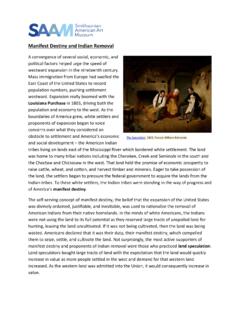Transcription of The Assimilation, Removal, and Elimination of Native Americans
1 Where higher learning meets faithful human DigniTyThe assimilation , Removal, and Elimination of Native Americansan experT guiDe by jessica keaTingCopyright 2020 McGrath Institute for Church Life, University of Notre Dame. Content created by Jessica Keating directs the Notre Dame Office of Life and Human Dignity in the McGrath Institute for Church Life. In her role, she leads the Institute s research, education, and outreach efforts on the nature and dignity of the human person and contemporary threats to the sanctity of life. Jessica also collaborates with schools and dioceses to develop innovative educational content and strategies to integrate a pedagogy of life across the academic originally hails from the Maryland suburbs of Washington, She completed her undergraduate degree in Philosophy and Sociology from St.
2 Joseph s University in Philadelphia, PA. She earned her Masters of Divinity from the University of Notre Dame in 2013. In addition to her work with the Institute, she is pursuing her in Systematic Theology at Notre her undergraduate and Masters degrees, Jessica taught high school theology for five years at Red Cloud Indian School on the Pine Ridge Indian Reservation in South Dakota. Jessica s writing has appeared in popular publications such as, America Magazine, Aleteia, The Imaginative Conservative, and the Catholic Catalogue, as well as a in the volume of essays, Dante, Mercy, and the Beauty of the Human assimilation , Removal, and Elimination of Native Americans3 Table of ContentsAn Overview of assimilation , Removal, and Elimination .
3 4 assimilation ..6 Conditions of Boarding Schools ..7 Removal ..9 Elimination : Destruction of the Buffalo ..11 Massacres ..12 The Impact of Native American assimilation , Removal, and Elimination ..13 Intersection of Native American assimilation , Removal, and Elimination with Human Dignity ..14 References and Recommended Resources ..15An Overview of assimilation , Removal, and Elimination Native peoples encountered non- Native groups, including the Spanish, French, and Norse, as early as the 16th century. Although colloquially Americans tend to refer to indigenous groups as Native Americans or Indians, there existed and still exists tremendous diversity among Native peoples.
4 When the first European settlers encountered Native groups in what is present-day United States, they encountered diverse peoples and tribes, ranging in size and organization, and with distinct cultures and ways of life. In other words, there is no such thing as a generic Native American. Likewise, the Native experience of European settlement and expansion was not monolithic as some over-simplified histories tend to imply; rather, it varied greatly across time and indigenous groups. For example, some Native groups engaged in lively trade with European traders-- the fur trade with the French, is just one example--and Jesuit priests, known as Black Robes learned the Lakota language and lived with tribal communities, from the late 16th- to early 19th-century.
5 However, alongside this history of economic and intercultural encounters between Native peoples and Euro- Americans , is a long history of systematic policies of assimilation , removal, and even Elimination , particularly during the sixty year period between 1830-1890. Though Native tribes did not all have the same experiences with US government officials or its policies, it is possible to form a general picture of how these policies impacted various Native peoples. The government s programs of assimilation , removal, and, when necessary, Elimination , wrought profound and lasting effects on Native American tribes and communities.
6 According to the Enlightenment ideal of progress that characterized the 19th century, many white Americans believed that Native peoples were not only capable of radically changing their cultures and lifestyles, but that Native people would even view assimilative measures of advancement as preferable over their own culture. The government advanced assimilative "They made us many promises, more than I can remember, but they never kept but one; they promised to take our land, and they took it." 1 CHIEF RED CLOUD1 Dee Brown, Bury My Heart at Wounded Knee: An Indian History of the American West (New York: Henry Holt & co. 2000 [1970]), assimilation , Removal, and Elimination of Native Americans4 Prior to the 1960s and 70s, the words savages and redskins were common in letters and government documents.
7 Even today, history textbooks still use the word, savage to describe Native people in general and the term squaw, a slur directed toward indigenous women. Some of these slurs come directly from government propaganda campaigns that have tried to portray Native people as uncivilized. The remnants of such derogatory propaganda is still evident in the names and mascots of various sports in several ways, including stipulations laid out in treaties. For instance, treaties with the Plains tribes, such as the Crow, Sioux, and Cheyenne, often required that they give up the traditional ways of life, including the practice of traditional religion, and stop harassing the westward flow of white settlers in exchange for food and other goods, the promise of land, as well as protection against white encroachment on their lands.
8 The government repeatedly broke these treaties when they impeded access to desirable land or gold. assimilation was also advanced through education. More progressive government officials and ecclesial groups, some of whom considered themselves friends of the Native Americans , created schools and institutions which aimed to assimilate Native peoples into Euro- Americans culture and values. In addition to assimilative policies, the government also seized Native lands. The rise of the doctrine of Manifest Destiny, with its emphasis on the Enlightenment ideal of progress, purportedly justified westward expansion across the entire continental United States as the divinely ordained destiny of the American project, and with it, the invasions and appropriation of Native lands.
9 As the US government and white settlers saw it, the advancement of the American project sanctioned the systematic and forcible removal of Native groups. For instance, in his first speech to Congress in 1829, newly elected president, Andrew Jackson, known as Sharp Knife among Native peoples, proposed the establishment of a permanent Indian frontier. He recommended the removal of all Native tribes in the eastern United States to the ample district west of the Mississippi where they would be left undisturbed by Many remnant tribes in what was by that time the eastern United States, including Hurons, Miamis, Shawnees, and Ottawas, along with the Choctaws, Chickasaws, Seminoles, and Creeks gave up their ancestral lands and made their way West.
10 Others, such as the Cherokee, were forcibly removed from their homelands, and were herded like cattle hundreds of miles to the westward to government designated territories. Among the most infamous of these forced removals is the Trail of Tears, during which one in every four Cherokees died from disease, exposure, or The Trail of Tears is perhaps the best known instance of forced relocation, but the government also implemented many other forced removals, including the infamous Navajo Long Brown, 5. assimilation , Removal, and Elimination of Native Americans5 assimilation Different groups had different motives for promoting boarding schools.




